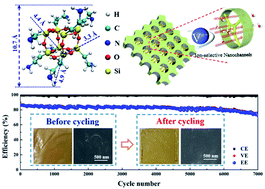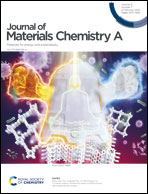Nanocage-oriented induction for highly ion-selective sub-1-nanometer channels of membranes†
Abstract
Designing membranes with highly ion-selective conductivity is one of the key questions for the large-scale application of redox flow batteries, which can unlock the potential of the renewable energy industry. The selectivity of ion exchange membranes is usually limited by the larger size of the nanochannels than that of redox-active ions. Herein, sub-1-nanometer channels of membranes were constructed through covalently bonding the polysilsesquioxane nanocages with multiple branched amino groups onto a polymer material. The synergistic effect of super hydrophilicity, extra functional amino groups and matched sub-1-nanometer sieve structure accomplished the sieving of proton to redox-active ions and ensured fast proton conduction. The ultrahigh proton-selective conductivity of 1.18 × 1011 mS s cm−3 enabled high electrochemical performance and surprisingly excellent durability over 7000 cycles (>4000 deep cycles for energy applications) even in the harsh environment of a vanadium flow battery. These results indicated that the new membrane design with multi-scale ion-sieving nanochannels is promising for high-efficiency and durable redox flow batteries.

- This article is part of the themed collection: Journal of Materials Chemistry A HOT Papers


 Please wait while we load your content...
Please wait while we load your content...